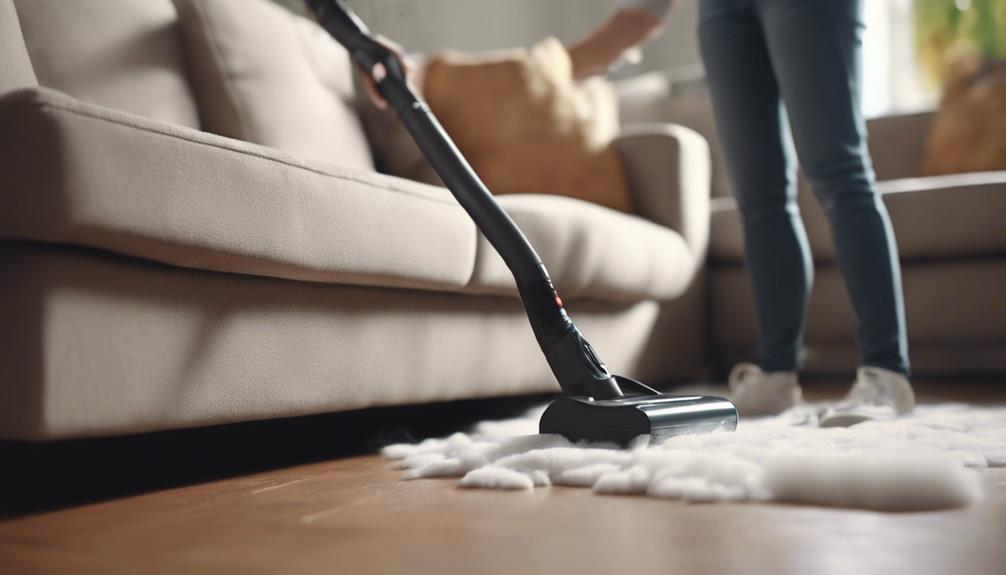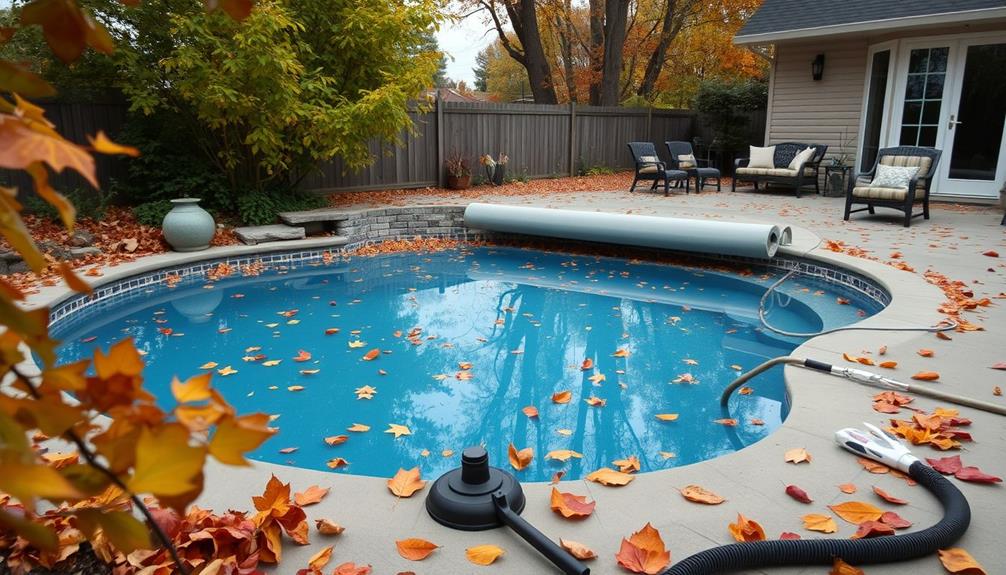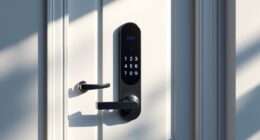For your hardwood floors to shine, start by choosing a pH-neutral cleaner or a natural option like vinegar. Mix warm water with detergent and add maintenance solutions for extra shine. Consider your flooring type and use soft mops to avoid damage. Place protective pads under furniture legs and strategically position rugs to prevent damage. Develop a regular cleaning schedule and prevent debris from accumulating. Use soft mops, stay away from harsh chemicals, and vacuum frequently. Finish by using gentle cleaners such as Murphy’s Oil Soap and rotate and clean rugs regularly. By following these suggestions, your hardwood floors will shine beautifully!
Key Takeaways
- Use pH-neutral cleaners to maintain shine and protect hardwood floors.
- Implement a regular cleaning routine with warm water and detergent.
- Avoid abrasive tools and harsh chemicals to prevent floor damage.
- Protect floors with rugs and furniture pads in high-traffic areas.
- Opt for gentle cleaning tools like soft mops and microfiber cloths.
Choose the Right Cleaner
To keep your hardwood floors looking their best, start by selecting a cleaner specifically formulated for hardwood surfaces. Using the right hardwood floor cleaner is important to avoid damage to the finish.
Look for pH-neutral cleaners that won't leave streaks or residue on your beautiful floors. These cleaners are gentle yet effective in lifting dirt and grime without harming the wood.
Harsh chemicals and abrasive cleaners should be avoided as they can strip the floor's finish and shine, causing long-term damage. Opting for natural cleaners like vinegar or specialized hardwood floor cleaners is a safe choice to maintain the integrity of your floors.
Use Warm Water and Detergent
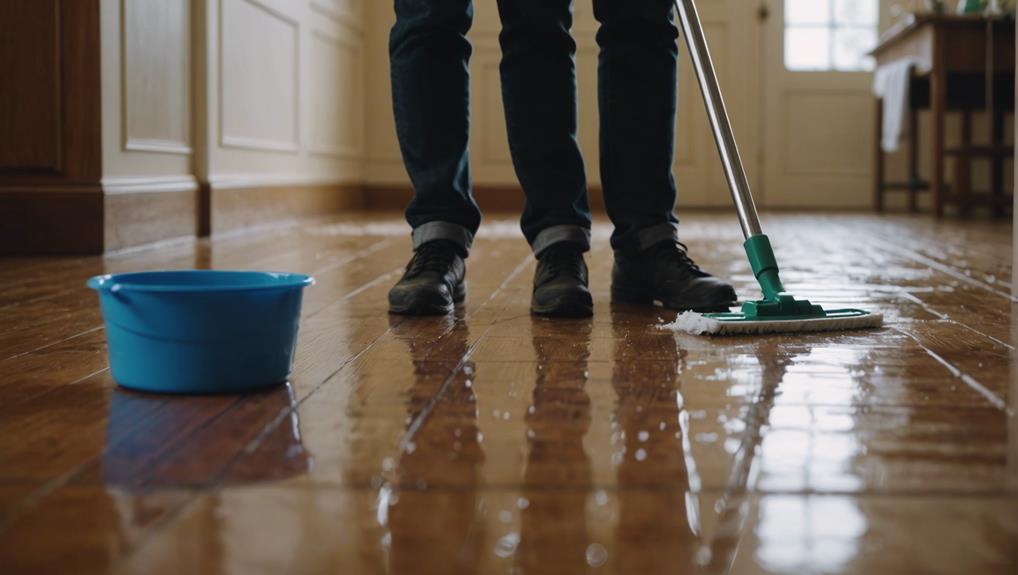
To effectively clean your hardwood floors, start by using a mixture of warm water and detergent. This combination helps to lift dirt and stains gently without damaging the floor's finish.
Proper Cleaning Technique
Warm water and detergent serve as a powerful duo for effectively cleaning hardwood floors without compromising their finish. When cleaning your hardwood floors, it is essential to use the right technique to maintain their integrity. Warm water helps dissolve dirt, while detergent aids in breaking down tough stains for a thorough clean. Here is a simple guide to help you properly clean your hardwood floors using warm water and detergent:
| Step | Instructions |
|---|---|
| 1. Sweep | Remove loose debris and dust with a soft-bristle broom. |
| 2. Mix Solution | Dilute a small amount of detergent in warm water. |
| 3. Mop | Dip a mop in the solution and wring it out well. |
| 4. Clean | Gently mop the floor, ensuring not to leave excess water. |
Choosing the Right Detergent
Selecting the appropriate detergent is essential for maintaining the cleanliness and finish of your hardwood floors when using warm water for cleaning.
When cleaning hardwood flooring, it's vital to choose a suitable cleaning solution that effectively removes dirt and grime without damaging the wood. Warm water mixed with a mild detergent is a key and efficient option for this purpose.
The warm water helps to lift stains and dirt from the floor's surface, while the detergent aids in breaking down tough residues. This combination is gentle yet powerful, ensuring a thorough cleaning without leaving behind any unwanted residue.
Make sure to properly dilute the detergent in warm water to prevent any potential buildup on the hardwood floors. By using the right detergent with warm water, you can effectively clean your hardwood floors while preserving their natural beauty and integrity.
Importance of Warm Water
For effective cleaning of your hardwood floors, combining warm water with the right detergent is vital. Warm water plays a significant role in breaking down dirt and grime on hardwood floors more effectively than cold water. It helps prevent streaking and residue buildup, leaving your floors sparkling clean.
When warm water is mixed with detergent, it creates a gentle yet powerful solution that effectively removes dirt without causing damage to your hardwood surfaces. The warmth of the water aids in loosening stubborn stains and sticky residues, making it easier to wipe them away.
Additionally, using warm water is a cost-effective and eco-friendly option for maintaining the beauty of your hardwood floors. By incorporating warm water into your cleaning routine, you can guarantee that your hardwood floors remain in top condition, free from dirt and grime.
Opt for Maintenance Solutions
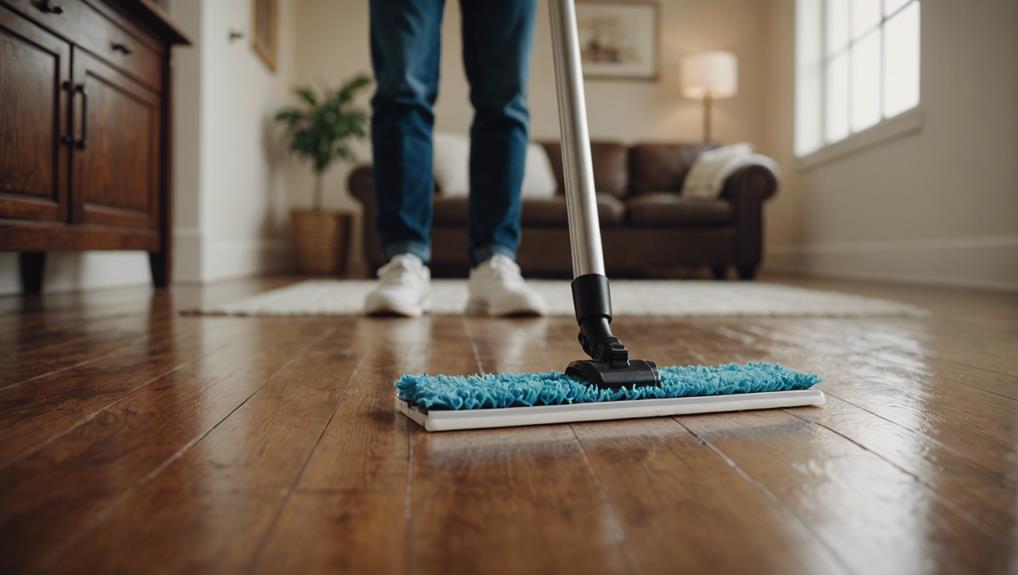
Consider incorporating maintenance solutions specifically designed for hardwood floors to effectively preserve their shine and integrity. Using a hardwood floor cleaner as part of your regular cleaning routine can help prevent dirt buildup, scratches, and other damage that can diminish the appearance of your hardwood floors.
These maintenance solutions are formulated to provide proper care and maintenance, extending the lifespan of your floors and keeping them looking sparkling clean. By opting for products tailored to hardwood floors, you guarantee that your floors receive the specific care they need to stay in top condition.
Regularly applying these solutions is vital in maintaining the beauty and luster of your hardwood floors, making them a key component of your cleaning regimen. Remember that maintenance solutions are essential for preserving the shine and integrity of your hardwood floors, so choose products designed specifically for this purpose to keep your floors looking their best for years to come.
Keep Flooring Types in Mind
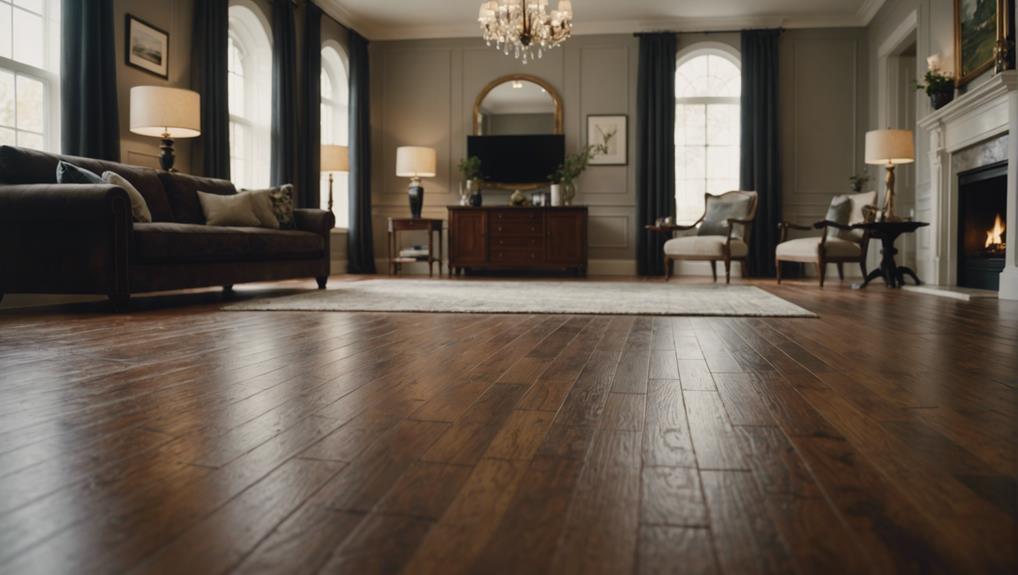
When selecting cleaning products and methods, it's important to bear in mind the specific type of hardwood flooring you have. Different flooring types, such as solid, engineered, or laminate floors, may require distinct care routines to maintain their shine and appearance. Understanding the characteristics of your flooring is vital in identifying the best cleaning and maintenance practices to make them sparkle.
For laminate floors, in particular, it's important to use floor cleaning products specifically designed for laminate surfaces. These products are formulated to clean effectively without causing damage to the laminate material. Unlike solid or engineered hardwood, laminate floors have a different composition that necessitates gentle cleaning solutions to preserve their look and durability.
Factors like the finish, sealant, and age of the hardwood can also influence the cleaning products and techniques you should use. By considering the unique properties of your hardwood floors, you can guarantee they maintain their desired sparkle and longevity in appearance.
Select Gentle Cleaning Tools
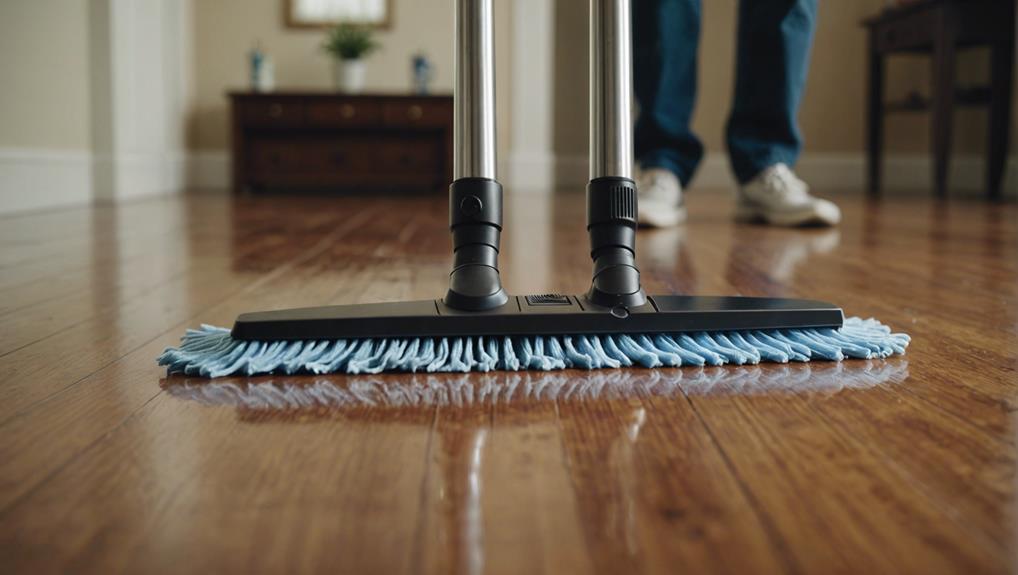
To maintain the sparkle of your hardwood floors, opt for soft mops and gentle cleaning tools that won't cause scratches or damage. When it comes to cleaning, selecting the right tools is crucial for preserving the beauty of your floors. Avoid abrasive brushes that can leave unsightly marks on your hardwood. Instead, opt for microfiber mops and cloths, which are designed to effectively capture dirt and debris without harming the floor's finish. The soft fibers of microfiber are gentle yet efficient, making them perfect for maintaining the shine of your hardwood floors. Always remember to use cleaning tools specifically designed for hardwood floors to guarantee proper care. Below is a table highlighting the importance of selecting gentle cleaning tools:
| Gentle Cleaning Tools | Benefits |
|---|---|
| Soft Mops | Prevent scratches and damage |
| Microfiber Cloths | Effectively capture dirt |
Address Accidents Promptly

Deal with mishaps promptly to safeguard the beauty and longevity of your hardwood floors. When accidents happen, such as spills or stains, it's important to clean them up immediately. Use a clean cloth or paper towel to blot the spill, avoiding rubbing, which can spread the liquid and potentially damage the wood.
For tougher stains, consider using a hardwood floor cleaner recommended by the manufacturer. Mop the affected area gently, following the wood grain to prevent any streaking. By cleaning up accidents promptly, you can prevent stains from setting in and causing permanent damage. This quick action not only preserves the floor's finish but also prevents the liquid from being absorbed into the wood.
Regularly addressing mishaps ensures that your hardwood floors remain clean, shiny, and free from stubborn stains, contributing to their overall beauty and integrity. Remember, swift action is key to maintaining the pristine condition of your hardwood floors.
Use Soft Mops
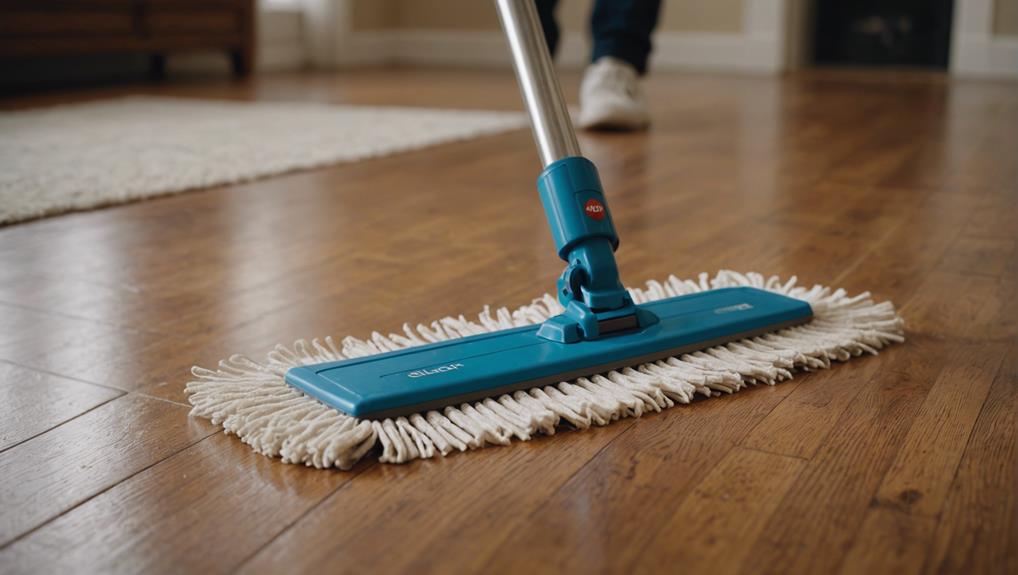
Soft mops are crucial for maintaining the cleanliness and shine of your hardwood floors. These mops are designed to be gentle on your floors, preventing scratches and damage while effectively picking up dirt and debris. By using a soft mop, you can guarantee that no residue is left behind, helping to maintain the floor's finish and shine without the use of abrasive materials. The soft fibers ensure a streak-free and polished look on your hardwood floors, keeping them looking their best.
To clean your hardwood floors using a soft mop, start by sweeping or vacuuming to remove loose dirt and debris. Then, dampen the mop with a solution of water and a hardwood floor cleaner or a mild soap like Oil Soap. Avoid using excessive water, as it can damage hardwood floors. Gently mop the floors, following the grain of the wood, to achieve a sparkling clean finish.
Regularly using a soft mop will help keep your hardwood floors looking beautiful for years to come.
Avoid Floor Damage
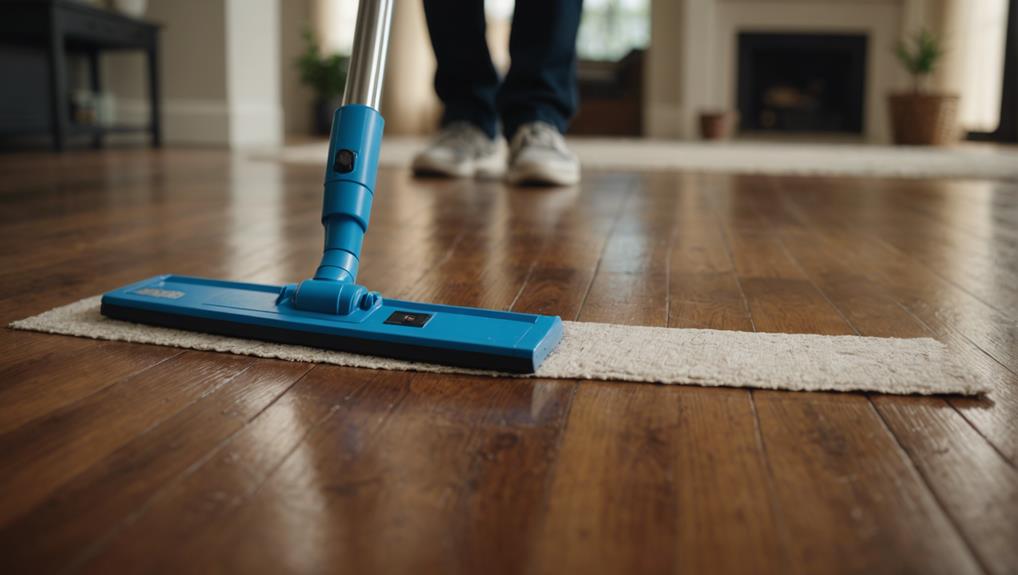
Maintaining the cleanliness and shine of your hardwood floors requires avoiding damage from harsh chemicals and abrasive tools. Using the wrong cleaning products can strip away the finish, leaving your floors vulnerable to wear and tear. Similarly, abrasive tools can scratch the surface, diminishing the overall appearance of your hardwood floors. To help you protect your floors, here are some key tips to prevent damage:
| Tip | Description |
|---|---|
| Use gentle cleaning products | Opt for hardwood floor cleaners specifically designed to maintain the finish. |
| Place protective pads under furniture | Prevent scratches and scuffs by placing felt or rubber pads under furniture legs. |
| Utilize rugs or mats in high-traffic areas | Reduce dirt and moisture buildup by using rugs or mats in frequently used areas. |
| Regularly clean to prevent wear and tear | Avoid dirt buildup that can wear down the finish and lead to a dull appearance. |
| Be cautious when moving heavy objects | Lift heavy furniture instead of dragging to prevent damage to the hardwood floors. |
Regular Cleaning Routine

To keep your hardwood floors looking their best, make sure to sweep or vacuum daily to remove dirt and debris.
Use a damp mop with a hardwood floor cleaner regularly to maintain their shine without damaging the wood.
Additionally, placing rugs or mats in high-traffic areas can help protect the floors from wear and tear.
Daily Sweeping and Mopping
Make sure to sweep or vacuum your hardwood floors daily to keep them looking their best. Sweeping removes dirt and debris that can dull the floor's shine, while vacuuming is efficient for larger areas.
Additionally, mopping with a damp cloth or mop helps maintain cleanliness and prevents scratches on the hardwood floors. These daily cleaning tasks are essential to prevent dirt buildup, which can wear down the floor finish over time.
By incorporating regular sweeping and mopping into your cleaning routine, you can preserve the natural beauty and shine of your hardwood floors. Consistency is key in ensuring that your floors sparkle and look their best every day.
Use Gentle Cleaners
For the best maintenance of your hardwood floors, incorporating gentle cleaners into your regular cleaning routine is vital. Gentle cleaners like Murphy® Oil Soap are ideal for preserving the integrity of your hardwood floors. Using warm water and detergent effectively removes dirt without causing any damage to the wood surface.
These maintenance solutions not only help prevent scratches but also combat dullness on your hardwood floors. By opting for cleaners that are gentle yet effective, you can guarantee that your hardwood floors remain sparkling clean.
Regularly cleaning with the right products is essential for maintaining the longevity and shine of your hardwood floors. Remember, choosing the appropriate gentle cleaners for your hardwood floors won't only keep them looking great but also protect them from unnecessary wear and tear.
Protect With Rugs
Place rugs strategically in high-traffic areas to safeguard your hardwood floors from scratches and wear. By placing rugs in these areas, you create a protective barrier that helps safeguard your beautiful floors.
Remember to regularly clean and shake out the rugs to remove dirt and debris that can scratch the floor's surface. Additionally, using rug pads underneath the rugs is crucial to prevent slipping and scratching, maintaining the integrity of your hardwood floor.
When selecting rugs, opt for ones with a non-abrasive backing to avoid any potential harm to the floor's finish. It's also beneficial to rotate the rugs periodically to guarantee even wear and sun exposure on the hardwood floor, prolonging its lifespan.
Prevent Debris Accumulation

To prevent debris accumulation on your hardwood floors, sweep or vacuum them daily. This simple task can help in maintaining the cleanliness and shine of your floors. Additionally, using rugs or mats in high-traffic areas is a great way to catch dirt before it spreads onto the hardwood floors. Regularly cleaning under furniture and in corners where debris tends to collect is also essential to prevent buildup. Another effective method is to avoid wearing shoes indoors as this can significantly reduce the amount of dirt and debris brought onto the floors. Implementing a no-shoes policy in your home can further minimize debris accumulation on your beautiful hardwood floors.
| Prevention Tips for Debris Accumulation | ||
|---|---|---|
| Daily Cleaning | Use Rugs in High-Traffic Areas | Regularly Clean Under Furniture |
| Sweep or vacuum floors daily | Place rugs or mats strategically | Don't forget corners and edges |
Frequently Asked Questions
How Do I Make My Hardwood Floors Sparkle?
To make your hardwood floors sparkle, start by cleaning them with a wood floor cleaner. Then, choose a suitable wood floor polish, apply it evenly, let it dry, and buff the floor in circular motions for a shiny finish.
How Do I Get My Dull Hardwood Floors to Shine Again?
To get your dull hardwood floors to shine again, start by removing dirt daily. Use a gentle cleaner and avoid harsh chemicals. Mop sparingly to prevent water damage. Buff dry after cleaning. Apply a quality polish to rejuvenate your floors.
Does Murphy's Oil Soap Shine Wood Floors?
Yes, Murphy's Oil Soap shines wood floors. It effectively cleans, conditions, and removes dirt without leaving a dull or sticky residue. Regular use can help maintain the natural shine of hardwood floors. Trusted by many homeowners for clean, glossy results.
Will Vinegar Make Hardwood Floors Shine?
Using vinegar to clean hardwood floors is effective for removing dirt and grime, but it won't necessarily make them shine. For that glossy finish, try a wood floor polish or restorer designed for shining hardwood surfaces.
Can the Tips for Making Hardwood Floors Sparkle also Work for Tile Floors?
If you’re wondering about the tips for making hardwood floors sparkle and whether they work for tile floors as well, the answer is yes! With the right techniques, you can learn how to shine tile floors just like hardwood. From cleaning to using the right products, you can achieve a sparkling finish on your tile floors.
How Can Vacuuming and Wiping My Hardwood Floors Help Make Them Sparkle?
Vacuum and wipe hardwood floors regularly to keep them looking their best. Removing dirt and debris with a vacuum can prevent scratches, while wiping with a damp cloth can help to remove stubborn stains and restore the shine. This simple maintenance routine can make your hardwood floors sparkle like new.
Conclusion
To sum up, by following these 10 tips, your hardwood floors will shine like a diamond in the rough.
With the right cleaner, gentle tools, and a regular cleaning routine, you can prevent debris accumulation and avoid floor damage.
So, roll up your sleeves, grab your mop, and get ready to make your floors sparkle like never before!

